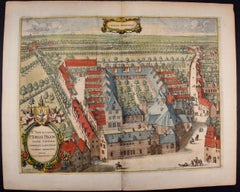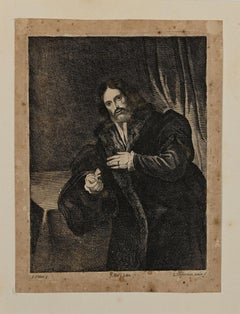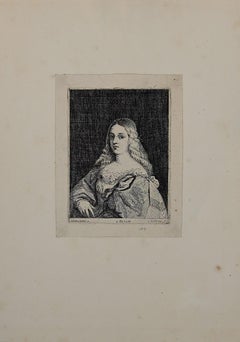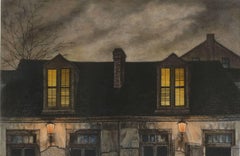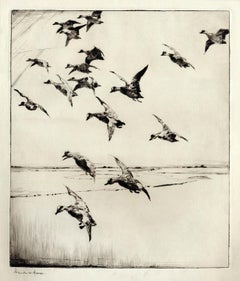Lucas Vorsterman the Younger Art
to
1
2
1
Overall Width
to
Overall Height
to
1
2
2
1
2
1
2
2
1
1
1
1
2
1
3
9,437
2,689
1,374
1,362
2
1
Artist: Lucas Vorsterman the Younger
Cartusia Bruxellensis Monastery in Brussels: A 17th C. Hand-colored Engraving
By Lucas Vorsterman the Younger
Located in Alamo, CA
This is a 17th century hand-colored copperplate engraving entitled "Cartusia Bruxellensis" by Lucas Vorsterman, the Younger, after a drawing by Jacob van Werden or Jacques van Weerden, published in 1659 in Antonius Sanderus' book 'Chorographia sacra Brabantiae sive celebrium aliquot in ea provincia ecclesiarum et coenobiorum descriptio . . . Brussel' (A sacred chorography of Brabant, or a description of several famous churches and convents in that province). It also appeared in other publications by Sanderus. In the 17th century, Brussels was within the Duchy of Brabant.
This engraving depicts a bird's-eye view of the Scheut Carthusian Monastery in Brussels. Scheut is a district of Anderlecht, a municipality of Brussels, Belgium. The monastery housed monks, who took a vow of silence, in 20 rooms. There is a central courtyard with trees and shrubs. Monks are depicted strolling along its pathways. The cells for the friars are in the middle the cloister. There are people along the streets in the foreground and to the right of the large, imposing monastery. Some are on horseback, others are walking. In the lower right, what appears to be a dog pulls a small cart containing barrels, possibly of beer or wine. Districts and neighborhoods are labelled in the background, including Scheut, Anderlecht and Ransfort. A very ornate cartouche in the lower left contains Latin and the artist's attribution. Another decorative cartouche in the upper central area contains the title.
This beautifully hand-colored and detailed engraving is printed on laid, chain-linked paper with wide, full margins. The sheet measures 17.25" high and 21.25" wide. It has Latin text on the verso. It has a central vertical fold, as issued, which is reinforced on the verso. Two small spots in the lower margin may actually represent drops of watercolor paint used to color the engraving. It is otherwise in very good condition.
Antonius Sanderus (1586-1664) was a Flemish Catholic cleric and historian. He was born "Antoon Sanders", but Latinized his name like many writers and scholars of his time. He was the author of several books, including 'Chorographia Sacra Brabantiae', which was illustrated with this engraving.
Lucas Vorsterman the Younger (1624-between 1666 & 1676) was a Flemish Baroque engraver and draughtsman. He produced engravings after the work of contemporary painters and for books by Antwerp publishers.
Jacob van Werden or Jacques van Weerden (active 1643-1669), was a Flemish draughtsman, cartographer, military engineer and archer who was active in the Habsburg Netherlands. His drawings were used as designs for prints executed by various printmakers. He worked on maps, topographical views, historical scenes, portraits and book illustrations. He had a career as a military engineer and a member of the guard of the Spanish King. He advised on various military engineering projects and was an engineer of the Spanish army...
Category
Mid-17th Century Old Masters Lucas Vorsterman the Younger Art
Materials
Engraving
Portrait - Etching by L. Vorfserman The Younger after Titian - 19th Century
By Lucas Vorsterman the Younger
Located in Roma, IT
Portrait is an artwork realized by L.Vorfterman the Youger after Titian, and printed in the second half of the 19th Century.
Original etching glued on ivory-colored paper.
Good c...
Category
19th Century Modern Lucas Vorsterman the Younger Art
Materials
Etching
Portrait - Etching by L.Vorsterman after I.Palma Senior - 19th Century
By Lucas Vorsterman the Younger
Located in Roma, IT
Portrait is an artwork realized by L.Vorsterman the Younger after I.Palma Senior and printed in the second half of the XIX century.
Original etching glued on ivory-colored paper.
...
Category
19th Century Modern Lucas Vorsterman the Younger Art
Materials
Etching
Related Items
Lafitte's Blacksmith House (a bar named for a pirate on Bourbon St, New Orleans)
By Frederick Mershimer
Located in New Orleans, LA
Lafitte's Blacksmith Shop is a New Orleans landmark at 941 Bourbon St. Like most New Orleans legends, history of Lafitte's Blacksmith Shop is a gumbo of tru...
Category
Early 2000s Contemporary Lucas Vorsterman the Younger Art
Materials
Mezzotint, Aquatint
Here They Come !
By Frank W. Benson
Located in New York, NY
This impression of "Here They Come !" is from the fourth state of eight. There are six known impressions of the fourth state. Edition 150 (final state). It is signed in pencil in the lower left and inscribed "D-1". The image size 13 7/8 x 11 3/4" (34.6 x 28.8 cm) and sheet size 16 3/4 x 14 5/8" (42.8 x 37.1 cm).
FRANK W. BENSON (1862-1951)
Frank Weston Benson, well known for his American impressionist paintings, also produced an incredible body of prints - etchings, drypoints, and a few lithographs. Born and raised on the North Shore of Massachusetts, Benson, a natural outdoorsman, grew up sailing, fishing, and hunting. From a young age, he was fascinated with drawing and birding – this keen interest continued throughout his life.
His first art instruction was with Otto Grundman at the Museum of Fine Arts in Boston, and then in 1883 in Paris at the Academie Julian where he studied the rigorous ‘ecole des beaux arts’ approach to drawing and painting for two years.
During the early 1880’s Seymour Haden visited Boston giving a series of lectures on etching. This introduction to the European etching...
Category
1920s American Impressionist Lucas Vorsterman the Younger Art
Materials
Drypoint
Catherina Dorothea Viehmann David Hockney Fairy Tales from the Brothers Grimm
By David Hockney
Located in New York, NY
The frontispiece for Hockney’s Six Fairy Tales from the Brothers Grimm portfolio and book features Catherina Dorothea Viehmann, the elderly German woman who recounted fairy tales to ...
Category
1960s Modern Lucas Vorsterman the Younger Art
Materials
Etching, Aquatint
$850
H 24.75 in W 17.75 in
Carte Particuliere Des Coste De Bretagne qui Comprend Morlaix
By Pierre Mortier
Located in Paonia, CO
Carte Particuliere Des Costes De Bretagne qui Comprend Morlaix, Saint Paul de Leon, les Sept Isles, et L’Isle. Faite par ordre Exprez Du Roy de France is from the collection of ch...
Category
1690s Lucas Vorsterman the Younger Art
Materials
Engraving
$1,350
H 25 in W 37.5 in
Carte Particular Des Costes De Bretagne Depuis le Cap de Frehel, Jusques a Perros
By Pierre Mortier
Located in Paonia, CO
Carte Particulaire Des Costes De Bretagne Depuis Le Cap de Frehel, Jusques a Perros, & L’Isle Tome. This large sea scale chart shows part of the northwestern co...
Category
1690s Lucas Vorsterman the Younger Art
Materials
Engraving
Collaborative Etching With 6 artist Hand Signed by 3 artists inc. Dorothy Dehner
By Adolph Gottlieb
Located in New York, NY
Adolph Gottlieb, David Smith, Dorothy Dehner, Edgar Levy, Lucille Corcos and Esther Gottlieb
Collaborative Etching With 6 artist (Hand Signed by 3 artist), ...
Category
Mid-20th Century Modern Lucas Vorsterman the Younger Art
Materials
Etching
$5,000
H 14.25 in W 12.75 in D 0.4 in
The Princess in her tower David Hockney Six Fairy Tales from the Brothers Grimm
By David Hockney
Located in New York, NY
One of David Hockney’s Six Fairy Tales from the Brothers Grimm illustrations, taken from the story of ‘The Little Sea Hare’. This tower was likely inspired by Hockney’s travels throu...
Category
1960s Modern Lucas Vorsterman the Younger Art
Materials
Etching, Aquatint
$2,000
H 24.75 in W 17.75 in
A View at Bolcheretzko (Russia) 1784 Captains Cook Final Voyage by John Webber
By John Webber
Located in Paonia, CO
A View at Bolcheretzko (Russia) is from the 1784 First Edition Atlas Accompanying Capt. James Cook and King; Third and Final Voyage of Captain James Cook.John Webber (1752-1793) was ...
Category
1780s Realist Lucas Vorsterman the Younger Art
Materials
Engraving
$540 Sale Price
40% Off
H 16.5 in W 13.5 in
LITHOGRAPHS Greenwich Village NYC, Signed Mezzotint, Art Gallery, Photorealism
By John Baeder
Located in Union City, NJ
LITHOGRAPHS Greenwich Village NYC by the American photorealist artist John Baeder is a limited edition mezzotint printed using hand printmaking techniques on archival, cream colored ...
Category
1970s Photorealist Lucas Vorsterman the Younger Art
Materials
Mezzotint
$446 Sale Price
25% Off
H 14 in W 23.75 in
The Princess after many years in the Glass Mountain by David Hockney fairy tale
By David Hockney
Located in New York, NY
This etching from David Hockney’s celebrated Six Fairy Tales from the Brothers Grimm portfolio depicts the somewhat obscure story Old Rinkrank, which Hockney chose to illustrate beca...
Category
1960s Modern Lucas Vorsterman the Younger Art
Materials
Etching, Aquatint
$1,100
H 24.75 in W 17.75 in
Restaurant in Mott Street
By Charles Frederick William Mielatz
Located in New Orleans, LA
The image depicts a restaurant on New York's Mott Street with ornamental iron work on the balconies. There are six figures in the scene in various stages of contrast. Mott Street is considered the unofficial Main Street of New York's Chinatown. Ella Fitzgerald sang it best: “And tell me what street compares with Mott Street in July? Sweet pushcarts gently gliding by.”
CFW Mielatz was an early influence on the drypoints and etchings of Martin Lewis. This piece was created in 1906 and it is signed in pencil. It is part of the collection of New York's Metropolitan Museum of Art
C.F.W. Mielatz
American, 1860-1919
Born in Bredding, Germany in 1864, Mielatz emigrated to the United States as a young boy and studied at the Chicago School of Design. Mostly self-taught, his first prints were large New England landscapes reminiscent of the painter-etcher school of American Art. Around 1890 he started to produce prints of New York City and by the time of his death, the number totaled over ninety images. He was a master technician in the field of etching, reworking many of his plates to get the exact feeling he was seeking. Mielatz was a member of the New York Etching...
Category
Early 20th Century American Modern Lucas Vorsterman the Younger Art
Materials
Drypoint, Etching
$400 Sale Price
27% Off
H 9.88 in W 6.25 in
Raoul Dufy - Champs Français - Original Etching
By Raoul Dufy
Located in Collonge Bellerive, Geneve, CH
Raoul Dufy - Champs Français - Original Etching
Dimensions: 13 x 10".
Edition of 200
1940
Edition Les Bibliophiles du Palais, Paris
Unsigned and unumbered as issued
Category
1940s Modern Lucas Vorsterman the Younger Art
Materials
Etching
Lucas Vorsterman The Younger art for sale on 1stDibs.
Find a wide variety of authentic Lucas Vorsterman the Younger art available for sale on 1stDibs. You can also browse by medium to find art by Lucas Vorsterman the Younger in etching, engraving and more. Much of the original work by this artist or collective was created during the 19th century and is mostly associated with the modern style. Not every interior allows for large Lucas Vorsterman the Younger art, so small editions measuring 8 inches across are available. Customers who are interested in this artist might also find the work of Frans Hogenberg, Giovanni Benedetto Castiglione, and Anthonie Waterloo. Lucas Vorsterman the Younger art prices can differ depending upon medium, time period and other attributes. On 1stDibs, the price for these items starts at $245 and tops out at $1,020, while the average work can sell for $245.
